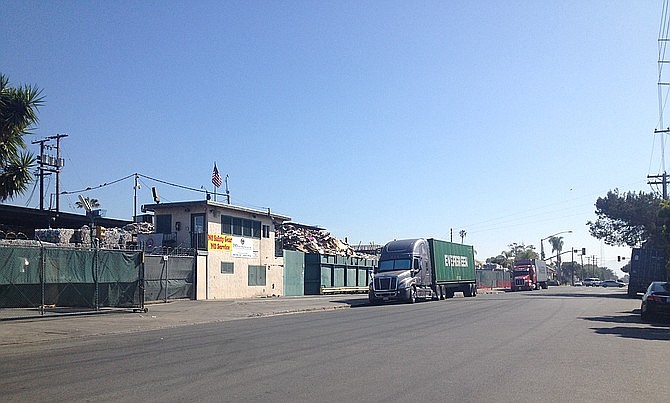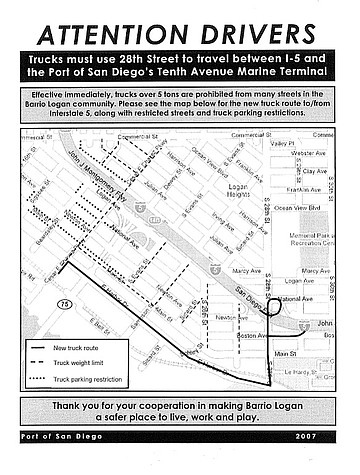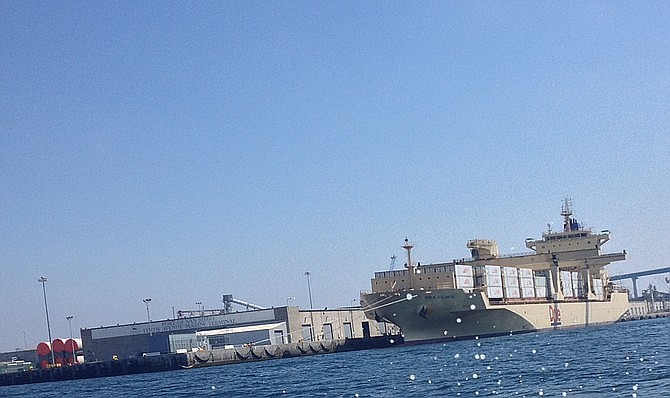 Facebook
Facebook
 X
X
 Instagram
Instagram
 TikTok
TikTok
 Youtube
Youtube

For decades, residents of Barrio Logan have been dealing with air and noise pollution from Port of San Diego semi-trucks taking unsanctioned short-cuts through their neighborhoods. Now the port is planning a 400 percent expansion of the Tenth Avenue Marine Terminal.
On March 15, the port announced a new planned traffic study to get a handle on the problem of port truck drivers not following the sanctioned route. The announcement was made at the Barrio Logan planning group meeting. According to Mark Steele, chair of the planning group, instead of coming from the other side of Harbor Drive, trucks are cutting through Cesar Chavez, Beardsley, Sigsbee, and other streets.
Jorge Gonzalez from the Environmental Health Coalition has been working closely with residents on this issue for years. According to Gonzalez, he was the one who proposed the traffic study.
Gonzalez said residents see trucks in their neighborhoods all the time. “In the middle of the day, during rush hour, in the evening. Around 6 p.m. to 10 p.m., you hear trucks on residential streets. At night is when you hear it the most.”

Gonzalez blames a lack of infrastructure and said that it’s more about how trucks exit Barrio Logan than how they enter. “The most impacted on-ramp is on Boston Avenue. Trucks should go to South Harbor from the Port, but during rush hour they do short-cuts onto Main Street and other adjacent streets.”
He also pointed to the other end of Boston that has one of the largest recycling centers in the area, where trucks enter and exit nearly hourly. “Now what’s about to happen — I just heard this recently — U-Haul is moving in where Bank of America used to be [National and Sampson]. You add that every single day, 100 to 200 trucks a day, people dropping off and in and out, it’s going to make the problem worse.”
Gonzalez said the Tenth Avenue Marine Terminal expansion will more than double the amount of trucks in the area. While he said that the situation has improved since 2005 — after trucks were banned from Cesar Chavez Parkway and other streets — the major issue is still too many cars all trying to leave from a one-lane access to an onramp on Boston Avenue that shouldn’t be there. “Sandag needs to work with the port on an alternative.”

According to a 2014 Department of Transportation document, 90 percent of Tenth Avenue Marine Terminal shipments travel out by truck; the other 10 percent go by rail.
Rafael Castellanos is on the port’s board of commissioners. He said they’re exploring the possibility of working with the City of San Diego and National City to make Harbor Drive improvements.
“A dedicated haul road would be very helpful. If we can direct trucks onto that route, that would help to get them out of the community. But we’ll need help with funding; it would take a lot of money, and we get no help from Sandag. Sandag tells us they aren’t responsible for the last mile between the coast and inland.”

Castellanos said the port has worked with nearby residents over the years to minimize their impact to the community. In 2014, the Barrio Logan gateway sign was installed in part to keep big trucks off Cesar Chavez Parkway (semi-trucks can’t clear it).
In 2012, Dole signed a 24.5-year lease with the port, which moved a Dole loading facility on Main Street to National City, which helped reduce traffic on Main. The terms of the lease stated that Dole would work with the port on infrastructure improvements as well as to improve the environment for the neighboring community. Castellanos said that Dole imports 180 million bananas a month through the Tenth Avenue Terminal.
Like Gonzalez, Castellanos says, “You get a lot of new drivers that aren’t familiar with the truck routes.”
Castellanos also pointed to Barrio Logan’s geographical grief of being sandwiched between port operations and Interstate 5 and the Coronado Bridge. “They get emissions from various directions. The port is just one factor.” He said the port takes the communities’ concerns seriously and they are doing what they can do to reduce greenhouse gases via their 2013 Climate Action Plan.
Gonzalez said, “Besides signage and enforcement, there needs to be penalties. New truck drivers need to face consequences. There has to be a cost of not following the truck route that is assigned.”
According to Castellanos, the community can report trucking concerns to the Port’s Marine Terminal Message Line at 619-686-8282. Gonzalez said resident complaints should go directly to Dan Valentine at the Tenth Avenue Marine Terminal.


For decades, residents of Barrio Logan have been dealing with air and noise pollution from Port of San Diego semi-trucks taking unsanctioned short-cuts through their neighborhoods. Now the port is planning a 400 percent expansion of the Tenth Avenue Marine Terminal.
On March 15, the port announced a new planned traffic study to get a handle on the problem of port truck drivers not following the sanctioned route. The announcement was made at the Barrio Logan planning group meeting. According to Mark Steele, chair of the planning group, instead of coming from the other side of Harbor Drive, trucks are cutting through Cesar Chavez, Beardsley, Sigsbee, and other streets.
Jorge Gonzalez from the Environmental Health Coalition has been working closely with residents on this issue for years. According to Gonzalez, he was the one who proposed the traffic study.
Gonzalez said residents see trucks in their neighborhoods all the time. “In the middle of the day, during rush hour, in the evening. Around 6 p.m. to 10 p.m., you hear trucks on residential streets. At night is when you hear it the most.”

Gonzalez blames a lack of infrastructure and said that it’s more about how trucks exit Barrio Logan than how they enter. “The most impacted on-ramp is on Boston Avenue. Trucks should go to South Harbor from the Port, but during rush hour they do short-cuts onto Main Street and other adjacent streets.”
He also pointed to the other end of Boston that has one of the largest recycling centers in the area, where trucks enter and exit nearly hourly. “Now what’s about to happen — I just heard this recently — U-Haul is moving in where Bank of America used to be [National and Sampson]. You add that every single day, 100 to 200 trucks a day, people dropping off and in and out, it’s going to make the problem worse.”
Gonzalez said the Tenth Avenue Marine Terminal expansion will more than double the amount of trucks in the area. While he said that the situation has improved since 2005 — after trucks were banned from Cesar Chavez Parkway and other streets — the major issue is still too many cars all trying to leave from a one-lane access to an onramp on Boston Avenue that shouldn’t be there. “Sandag needs to work with the port on an alternative.”

According to a 2014 Department of Transportation document, 90 percent of Tenth Avenue Marine Terminal shipments travel out by truck; the other 10 percent go by rail.
Rafael Castellanos is on the port’s board of commissioners. He said they’re exploring the possibility of working with the City of San Diego and National City to make Harbor Drive improvements.
“A dedicated haul road would be very helpful. If we can direct trucks onto that route, that would help to get them out of the community. But we’ll need help with funding; it would take a lot of money, and we get no help from Sandag. Sandag tells us they aren’t responsible for the last mile between the coast and inland.”

Castellanos said the port has worked with nearby residents over the years to minimize their impact to the community. In 2014, the Barrio Logan gateway sign was installed in part to keep big trucks off Cesar Chavez Parkway (semi-trucks can’t clear it).
In 2012, Dole signed a 24.5-year lease with the port, which moved a Dole loading facility on Main Street to National City, which helped reduce traffic on Main. The terms of the lease stated that Dole would work with the port on infrastructure improvements as well as to improve the environment for the neighboring community. Castellanos said that Dole imports 180 million bananas a month through the Tenth Avenue Terminal.
Like Gonzalez, Castellanos says, “You get a lot of new drivers that aren’t familiar with the truck routes.”
Castellanos also pointed to Barrio Logan’s geographical grief of being sandwiched between port operations and Interstate 5 and the Coronado Bridge. “They get emissions from various directions. The port is just one factor.” He said the port takes the communities’ concerns seriously and they are doing what they can do to reduce greenhouse gases via their 2013 Climate Action Plan.
Gonzalez said, “Besides signage and enforcement, there needs to be penalties. New truck drivers need to face consequences. There has to be a cost of not following the truck route that is assigned.”
According to Castellanos, the community can report trucking concerns to the Port’s Marine Terminal Message Line at 619-686-8282. Gonzalez said resident complaints should go directly to Dan Valentine at the Tenth Avenue Marine Terminal.
Comments